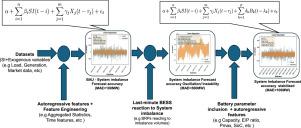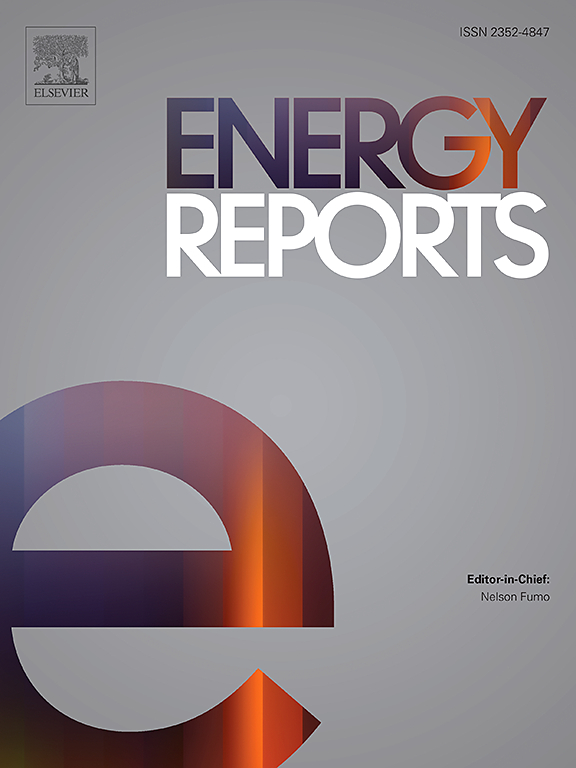Impact of BESS last-minutes reactions on short-term system imbalance forecasting accuracy in European energy markets
IF 5.1
3区 工程技术
Q2 ENERGY & FUELS
引用次数: 0
Abstract
The increasing deployment of Battery Energy Storage Systems (BESS) in modern electricity markets has introduced new complexities in system imbalance (SI) forecasting, particularly due to last-minute balancing actions by Balance Responsible Parties (BRPs). Conventional forecasting models, which primarily rely on historical imbalance patterns and exogenous market features, often fail to capture the dynamic corrective responses of BESS, leading to substantial prediction inaccuracies. This study systematically evaluates the impact of key battery parameters, including maximum power capacity (), depth of discharge , and energy-to-power ratio, on forecasting accuracy. A battery-aware autoregressive (AR) model is developed to explicitly integrate these factors, with predictive performance benchmarked against conventional models under both static and dynamic battery dispatch conditions. The analysis establishes well-defined operational stability constraints, demonstrating that forecast errors remain within considerably limits ( MW) when MW, , and the ratio is maintained either at or . However, within the intermediate range , forecast errors exceed 100 MW, introducing instability and reducing predictive reliability. Notably, when is below 416 MW, variations in and exhibit minimal influence on forecast accuracy concerning the 100 MW MAE threshold. These findings underscore the intricate interdependencies among BESS parameters, highlighting the destabilizing effects of high-power dispatch, extended storage durations, and deep discharge cycles beyond these defined thresholds. Comparisons against the Elia forecast and a Naïve benchmark confirm that the battery-aware model enhances forecasting accuracy, improving MAE by up to 13.39%, RMSE by 20.61%, and sign accuracy by 12.06% over the Elia baseline. These improvements demonstrate the necessity for forecasting models that explicitly integrate battery dynamics to enhance predictive stability in evolving electricity markets. While this study employs an autoregressive framework for demonstration, the methodology and insights extend to advanced machine learning and probabilistic forecasting approaches. The findings provide actionable guidance for Transmission System Operators (TSOs) and market participants, offering a structured approach for optimizing imbalance management strategies, enhancing grid stability, and improving forecasting resilience in power systems with increasing BESS deployments.

BESS最后时刻反应对欧洲能源市场短期系统不平衡预测准确性的影响
电池储能系统(BESS)在现代电力市场的日益普及给系统不平衡(SI)预测带来了新的复杂性,特别是由于平衡责任方(brp)在最后一刻采取的平衡行动。传统的预测模型主要依赖于历史失衡模式和外生市场特征,往往无法捕捉到BESS的动态修正响应,导致预测严重不准确。本研究系统地评估了电池关键参数,包括最大功率容量(Pmax)、放电深度(DOD)和能量功率比(E/P)对预测精度的影响。开发了一个电池感知自回归(AR)模型来明确地整合这些因素,并在静态和动态电池调度条件下与传统模型进行了预测性能基准测试。分析建立了明确的运行稳定性约束,表明当Pmax≈416 MW, DOD≤0.92,E/P比保持在E/P≤4.64或E/P≥6.94时,预测误差保持在相当大的范围内(MAE≤100 MW)。然而,在中间区间4.64<E/P<;6.94内,预测误差超过100 MW,引入不稳定性,降低预测可靠性。值得注意的是,当Pmax低于416 MW时,对于100 MW MAE阈值,E/P和DOD的变化对预测精度的影响最小。这些发现强调了BESS参数之间错综复杂的相互依赖关系,突出了高功率调度、延长存储持续时间和深度放电周期超出这些定义阈值的不稳定影响。与Elia预测和Naïve基准的比较证实,电池感知模型提高了预测精度,与Elia基线相比,MAE提高了13.39%,RMSE提高了20.61%,符号准确率提高了12.06%。这些改进证明了明确整合电池动态的预测模型的必要性,以提高不断变化的电力市场的预测稳定性。虽然本研究采用自回归框架进行演示,但其方法和见解扩展到先进的机器学习和概率预测方法。研究结果为输电系统运营商(tso)和市场参与者提供了可操作的指导,提供了一种结构化的方法来优化不平衡管理策略,增强电网稳定性,并在BESS部署增加的情况下提高电力系统的预测弹性。
本文章由计算机程序翻译,如有差异,请以英文原文为准。
求助全文
约1分钟内获得全文
求助全文
来源期刊

Energy Reports
Energy-General Energy
CiteScore
8.20
自引率
13.50%
发文量
2608
审稿时长
38 days
期刊介绍:
Energy Reports is a new online multidisciplinary open access journal which focuses on publishing new research in the area of Energy with a rapid review and publication time. Energy Reports will be open to direct submissions and also to submissions from other Elsevier Energy journals, whose Editors have determined that Energy Reports would be a better fit.
 求助内容:
求助内容: 应助结果提醒方式:
应助结果提醒方式:


